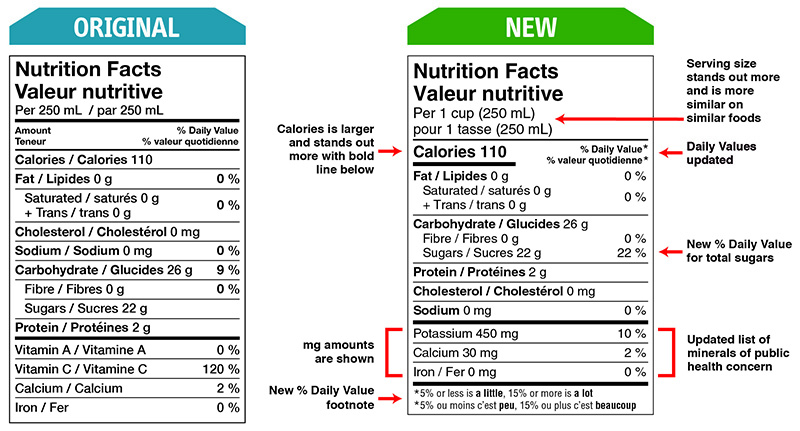The Nutrition Facts Table and Ingredient List
Under Government of Canada (2019a) regulations, the NFT must provide information about serving size, calories, percent daily value (% DV) of nutrients, and core nutrients. Currently, the requirements for nutrient information are changing and industry has five years to make changes so that NFT include: fat, saturated fat, trans fat, cholesterol, sodium, carbohydrate, fibre, sugars, protein, potassium, calcium, and iron (Government of Canada, 2019a; Government of Canada, 2017). Figure 2.2 illustrates the new NFT as compared with the original (i.e., the previous version).

The NFT displays the % DV so consumers can determine the amount of a certain nutrient in one serving. For example, the Government of Canada (2019b) indicates that 5% of the DV or less of a nutrient is considered “a little” while 15% of the DV or more of a nutrient is considered “a lot.” You should be aware that the % DV is not used to identify whether a person has had sufficient nutrients in a day, particularly considering that many foods do not require the NFT (Government of Canada, 2019b). Rather, it is best to talk with your clients about using the % DV to compare and make choices between different types of food that are higher in healthy nutrients (e.g., fibre) and lower in nutrients that are not healthy (e.g., sodium and trans fat) (Government of Canada, 2019b).
The list of ingredients (as illustrated in Figure 2.3) is mandatory on most packaged foods that contain more than one ingredient, and ingredients are listed in order of weight. The weight of ingredients listed will be an important aspect of your conversation with a client. You may choose to draw their attention to that aspect of food labelling and discuss with them how it might impact their food choices. In addition, caffeinated energy drinks require that the amount of caffeine is included with a statement that the product is a “high source of caffeine” and “not recommended for children, pregnant/breastfeeding women” (Canadian Food Inspection Agency, 2015).

Attribution statement
Unless otherwise noted, content from this page was adapted, with editorial changes, from Nutrition and Labelling for the Canadian Baker by go2HR and is used under a Creative Commons Attribution 4.0 International License.
The amount of a certain nutrient in one serving.

